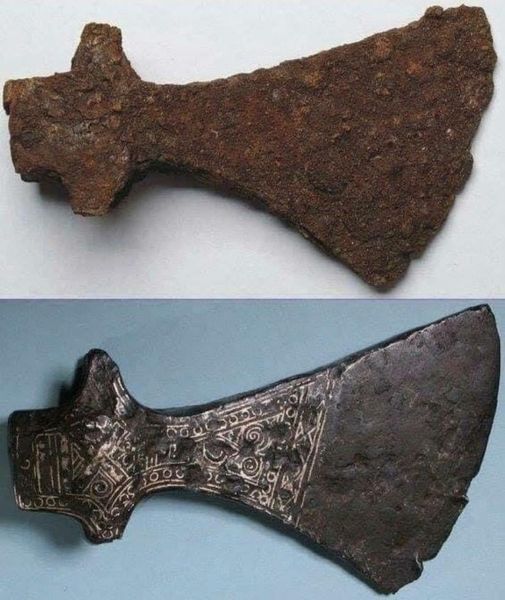In recent years, a striking silver-decorated axe has been making the rounds on various internet forums, touted as a “1000-year-old Viking axe” or a “Viking axe from the 10th-11th centuries.” This mysterious artifact has sparked the curiosity of many history enthusiasts, leaving them wondering about its authenticity and origins.
In this in-depth blog post, we’ll delve into the fascinating story behind this intriguing find, exploring the circumstances of its discovery, its detailed description, and the closest historical parallels that shed light on its true origins and dating. By the end, we’ll have a clearer understanding of this remarkable piece of history and its place in the rich tapestry of Viking-era weaponry.
The Axe from Gromovo

The axe in question was discovered in the spring of 2013 in the locality of Gromovo, situated in the Priozersk district of the Leningrad Oblast, Russian Federation. It was found alongside an iron scythe, approximately one meter below the surface.
Subsequent archaeological investigations in the area revealed the presence of disturbed graves dating back to the 13th-14th centuries. The axe was assigned to grave no. 1, which also contained a scythe, a knife, a razor, and the remains of a belt. The publication of the material from this locality was undertaken by the lead researcher, archaeologist S.V. Belskij, in 2018.
Currently, the axe is housed in the Kunstkamera Museum in St. Petersburg, Russia, under the inventory number МАЭ № 7614-1.
Description of the Axe

The axe takes the form of Petersen type M and Kirpičnikov type VII, measuring 14.2 cm in length with a 10 cm blade. The blade has a maximum thickness of 0.7 cm, while the butt stands 3 cm high and 1.1 cm thick. The eye of the axe is lenticular or ovoid in shape.
During the restoration process, an intricate ornamental inlay made of thin silver wire was discovered. This decoration is visible on one side of the axe when carried on the right side. The ornament features long lines and spirals that cover the blade (including its upper edge), the thorns, and the butt, while the central part of the blade remains undecorated.
Conclusion
The “1000-year-old Viking axe” that has been circulating on the internet is not a fake or a forgery. It is a genuine artifact that was discovered in Gromovo, Russia, in 2013, and it can be firmly dated to the late 12th and early 13th centuries based on its close stylistic parallels with other weapons from the Baltic and Scandinavian regions.
While the axe may not be as ancient as some had claimed, its intricate silver decoration and the insights it provides into the material culture of the time period make it a remarkable and valuable find. This discovery sheds light on the artistic traditions and technological capabilities of the people who inhabited these regions during the late medieval period.

As we continue to uncover and study artifacts like this “Viking axe,” we gain a deeper understanding of the rich history and cultural exchanges that took place in the Baltic and Scandinavian worlds. This axe serves as a tangible link to the past, inviting us to explore the stories and craftsmanship that lie behind these remarkable objects.
If you have any further questions or would like to learn more about this fascinating find, please feel free to reach out. I’m always eager to engage in discussions about historical artifacts and the insights they can provide into the past.
